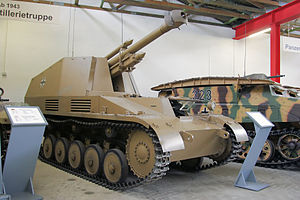SdKfz 124 Wespe
| Wespe | |
|---|---|

Wespe at the Deutsches Panzermuseum in Munster, Germany
|
|
| Type | Self-propelled artillery |
| Place of origin | Nazi Germany |
| Service history | |
| In service | 1943 - 1945 |
| Used by | Nazi Germany |
| Wars | World War II |
| Production history | |
| Designer | Alkett |
| Designed | 1942 |
| Manufacturer | Famo-Ursus |
| Produced | 1943 - 1944 |
| No. built | 676 |
| Variants | ammunition carrier |
| Specifications | |
| Weight | 11 tonnes (24,250 lb) |
| Length | 4.81 m (15 ft 9 in) |
| Width | 2.28 m (7 ft 6 in) |
| Height | 2.3 m (7 ft 7 in) |
| Crew | 5 (commander, driver, three gunners) |
|
|
|
| Armor | 5 - 30 mm (.19 - 1.18 in) |
|
Main
armament |
1x 10.5 cm leFH 18/2 L/28 with 40 rounds |
| Engine | 6-cyl petrol Maybach HL 62 TR 140 PS (138 hp, 103 kW) |
| Power/weight | 12.7 PS/tonne |
| Suspension | leaf spring |
|
Operational
range |
220 km (137 mi) |
| Speed | 40 km/h (25 mph) |
The Sd. Kfz. 124 Wespe (German for "wasp"), also known as Leichte Feldhaubitze 18/2 auf Fahrgestell Panzerkampfwagen II (Sf.) ("Light field howitzer 18 on Panzer II chassis (self-propelled)"), is a German self-propelled gun developed and used during the Second World War. It was based on a modified Panzer II chassis.
During the Battle of France in 1940 it became apparent that the intermediate tank of the German forces, the Panzer II, was unsuitable as a main battle tank. Though mechanically sound, it was both under-gunned and under-armoured. The chassis, however, proved servicable for providing mobility to the 10.5 cm field howitzer. Existing chassis were converted to self-propelled artillery vehicles, such as the Marder II conversion providing mobility to the PaK 40/7.5 cm anti-tank gun.
The design for the Wespe was produced by Alkett, based on the Panzer II Ausf. F chassis. Alkett had earlier worked with Alfred Becker to convert captured French armoured vehicles into self-propelled artillery carriers. Among other modifications the Panzer II's engine was moved forward and the chassis slightly lengthened to accommodate the rear-mounted 10.5 cm leFH 18 howitzer. The superstructure was lightly armored, with 10 mm armor plate (enough to stop small arms fire) left open at the top and rear. The vehicles were produced by FAMO's Ursus plant in Warsaw.
The Wespe was in production from February 1943 until June 1944, when Soviet forces approached the frontier. By that time, 676 had been produced. An additional 159 were modified to serve as mobile artillery ammunition carriers.
The Wespe first saw combat in 1943 on the Eastern Front. It proved very successful, and Hitler ordered all Panzer II chassis production be dedicated to the Wespe alone, at the expense of other projects, including the Marder II self-propelled anti-tank gun.
...
Wikipedia
